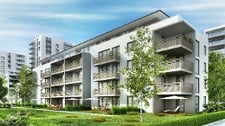 Architects play a critical role in the push to decarbonize the built environment, which accounts for 40 percent of global CO2 emissions. A new and urgent global appeal to architects to accelerate their participation in decarbonization is being driven by the founder of Architecture 2030, Edward Mazria. He recently wrote an open letter urging designers to cut carbon emissions in response to a new intergovernmental assessment on climate change. In that letter, Mazria highlights three steps designers can take to accelerate zero carbon goals.
Architects play a critical role in the push to decarbonize the built environment, which accounts for 40 percent of global CO2 emissions. A new and urgent global appeal to architects to accelerate their participation in decarbonization is being driven by the founder of Architecture 2030, Edward Mazria. He recently wrote an open letter urging designers to cut carbon emissions in response to a new intergovernmental assessment on climate change. In that letter, Mazria highlights three steps designers can take to accelerate zero carbon goals.
Design to the latest code standards
Key to driving net zero carbon goals is designing buildings to the most current energy code standards – ASHRAE 90.1 2019, IECC 2021, or better. Unfortunately, most local building codes prescribe the minimum acceptable level of efficiency, which falls well below the ideal level. However, code minimums requirements do not prevent architects, designers, and building energy professionals from designing to the most efficient standards to ensure energy efficiency in buildings.
Cost-effectiveness is often cited as a primary concern for buildings in achieving code requirements. However, designing to current standards can be done cost-effectively. With ready-to-use energy modeling compliance tools like COMcheck and REScheck, trade-off options are available to design energy-efficient residential and commercial buildings.
Design all-electric plus renewable
Reducing fossil fuels is essential, so all new building designs should use no gas, oil, or propane. Fossil fuel use accounts for 5.4 percent of all GHG emissions, and burning gas, oil, and propane accounts for 35 percent of all U.S. CO2 emissions. Therefore, reaching the carbon reduction goal will require buildings to be designed all-electric with electricity supplied by onsite or new offsite renewable energy.
Converting to all-electric has demonstrated economic and environmental benefits and will spur the expansion of new renewables to decarbonize power and, in turn, the building sector.
Zero out embodied carbon
As steps one and two will produce zero carbon building operations, it’s also critical that those efforts be matched by reducing embodied carbon in building materials. Mazria calls on architects and designers to minimize carbon emissions in all new buildings, major renovations, infrastructure projects, and construction by:
Reusing – repurposing and upgrading existing buildings instead of constructing new buildings whenever possible
Reducing – specifying low- to zero-carbon building materials using comparison tools like the Embodied Carbon in Construction Calculator
Sequestering – using mass timber and glue/cross-laminated wood from existing sustainably managed forests; use bamboo structural panels, for example, and specify materials that sequester CO2 in their manufacture or application
Greater sense of urgency
According to the U.S. Environmental Protection Agency, global average surface temperature has risen at an average rate of 0.17º F per decade since 1901, similar to the rate of warming within the contiguous 48 states. Since the late 1970s, however, the United States has warmed faster than the global rate. Mazria notes that while 20 years ago achieving net zero seemed like a far-off aspiration, today, the tools, knowledge, and standards are available to hit that target.
The question is, will there be increased momentum to tackle this critical goal?
What are your thoughts?





